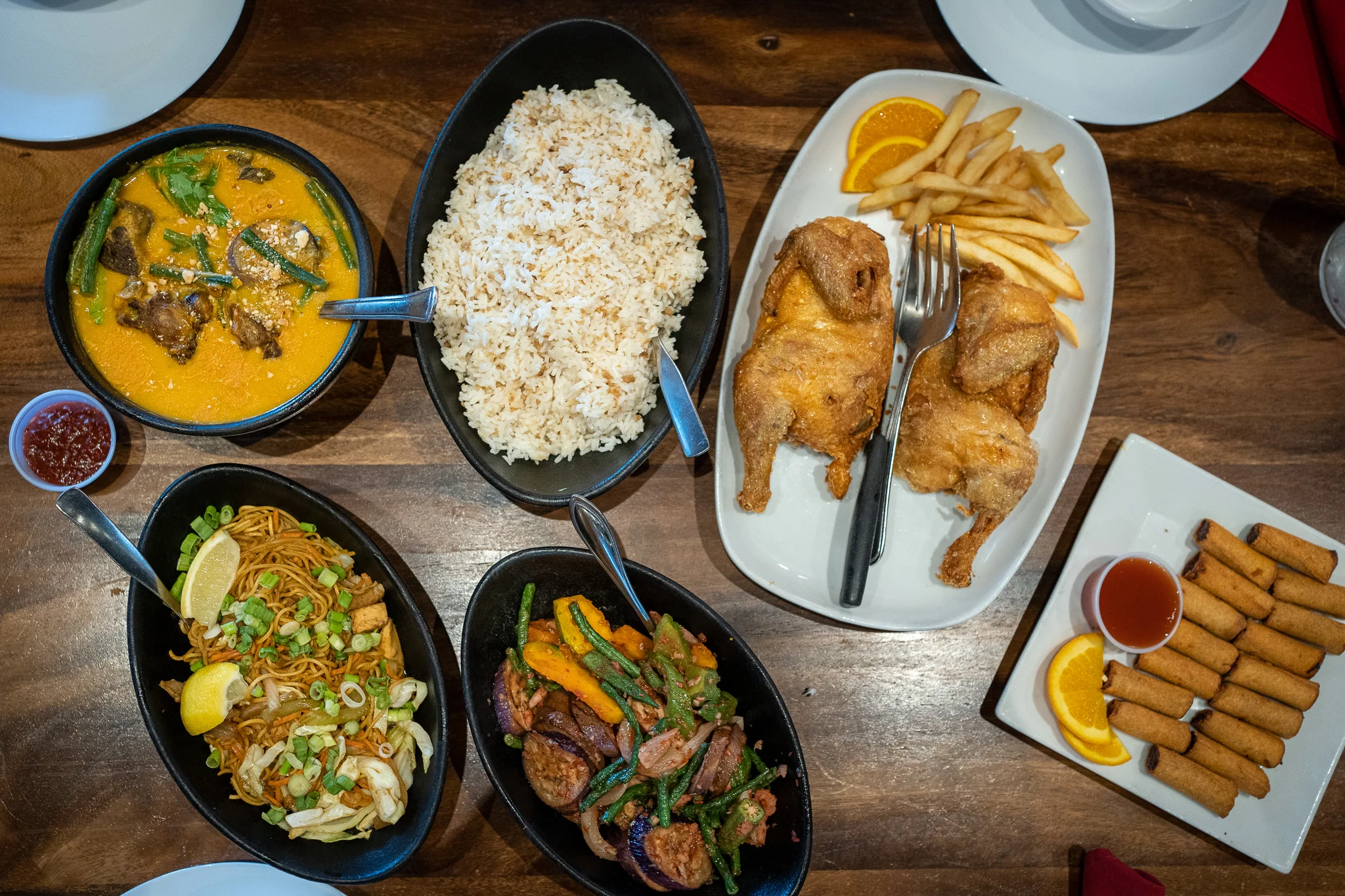Updated: 4/12/2024 | Popular Filipino Dishes You MUST Try
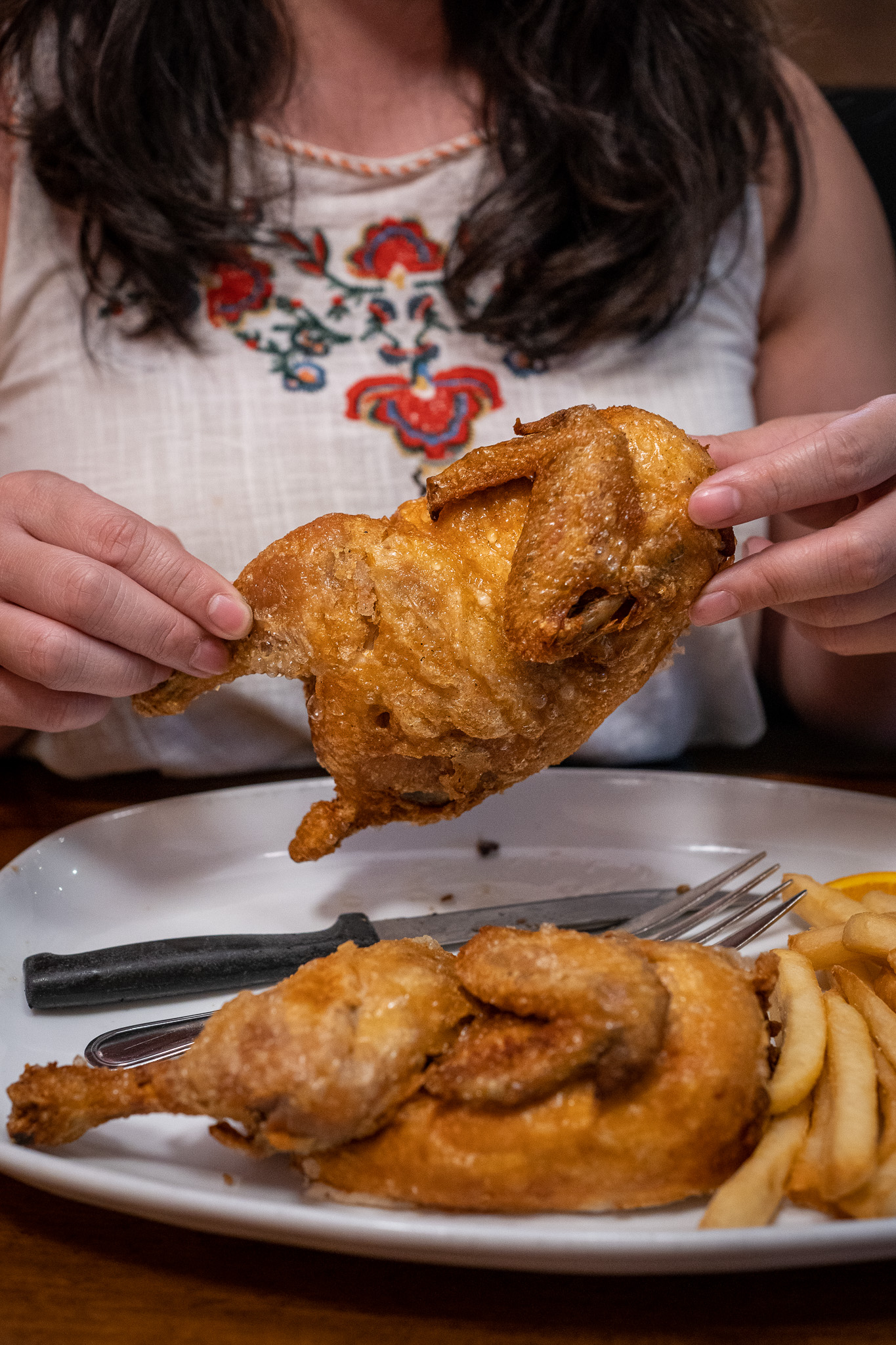
Famous Deep Fried Chicken from Max’s Restaurant
Popular Filipino Dishes You MUST Try
Appetizers
Lumpia
Lumpia is essentially Chinese eggrolls done Filipino style.
Lumpia was introduced to the Philippines during the pre-colonial period by Hokkien immigrants and traders from Fujian between 900 and 1565 AD. The name is derived from Hokkien, a language that originated in southeastern China. “Lun” means wet, moist, or soft, and “pia” means cake or pastry, hence the name lumpia!
It’s a delicious mix of ground pork and vegetables rolled in egg wrapper and deep-fried. It’s typically served with a sweet and sour sauce on the side and can be eaten alone. You’ll find yourself eating more than one.
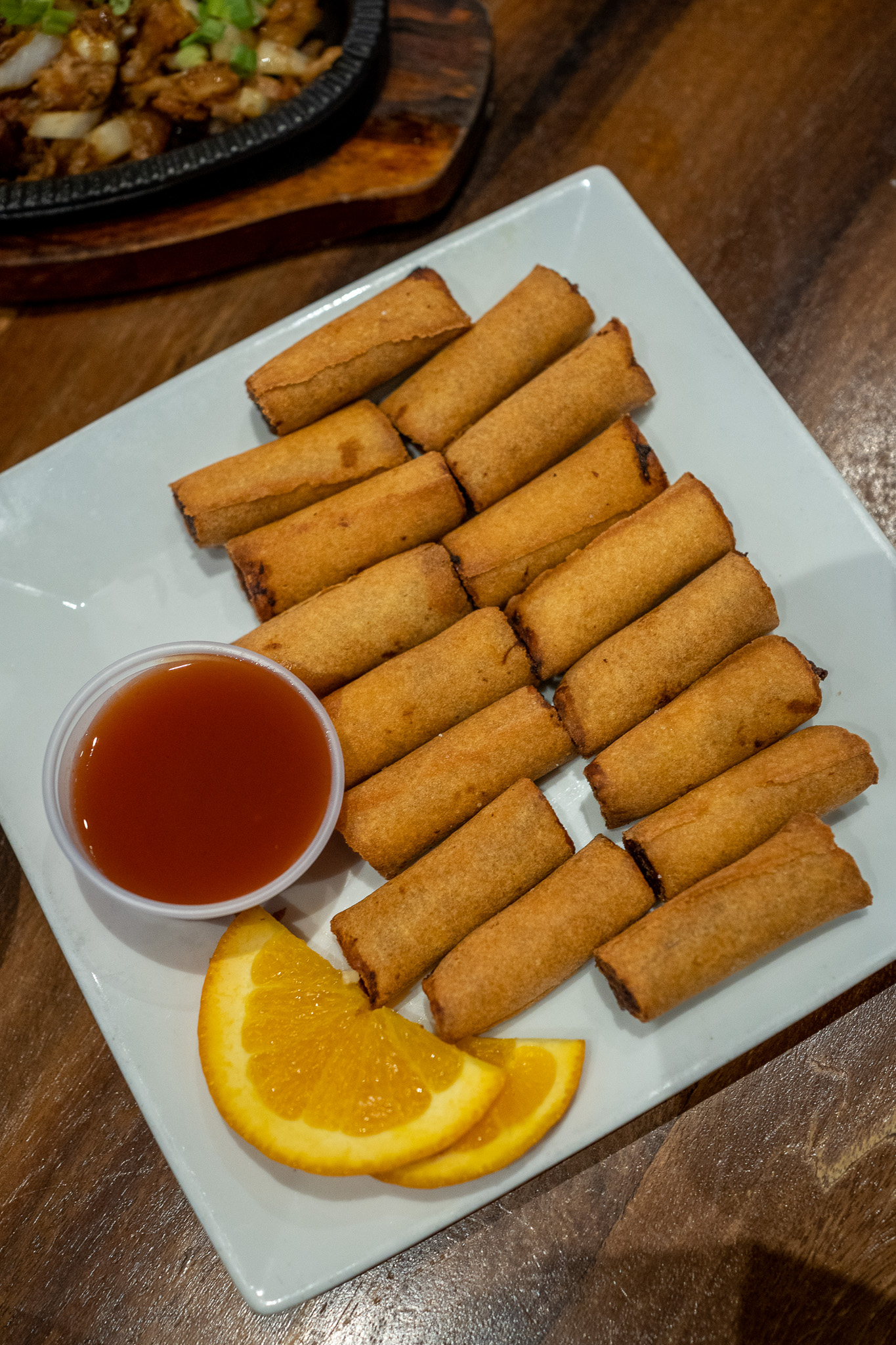
Lumpia from Max’s Restaurant
Chicharon Buklaklak (Crispy Ruffle Fat)
Crispy pork ruffle fat that is deep fried and served with a vinegar garlic dip. It’s typically served as street food.
If you see it available on a menu, definitely order it.
Longanisa
Longanisa is derived from the Spanish word longaniza which includes any type of sausage made from chorizo. In Filipino longaniza is typically sweet (or hamonado) and is eaten for breakfast with rice (plain, garlic or fried) and a fried egg.
We got to try a delicious longanisa from Oriental Mart in Seattle, Washington. Their longanisa is sweet and savory and pairs perfectly with their spiced vinegar sauce.
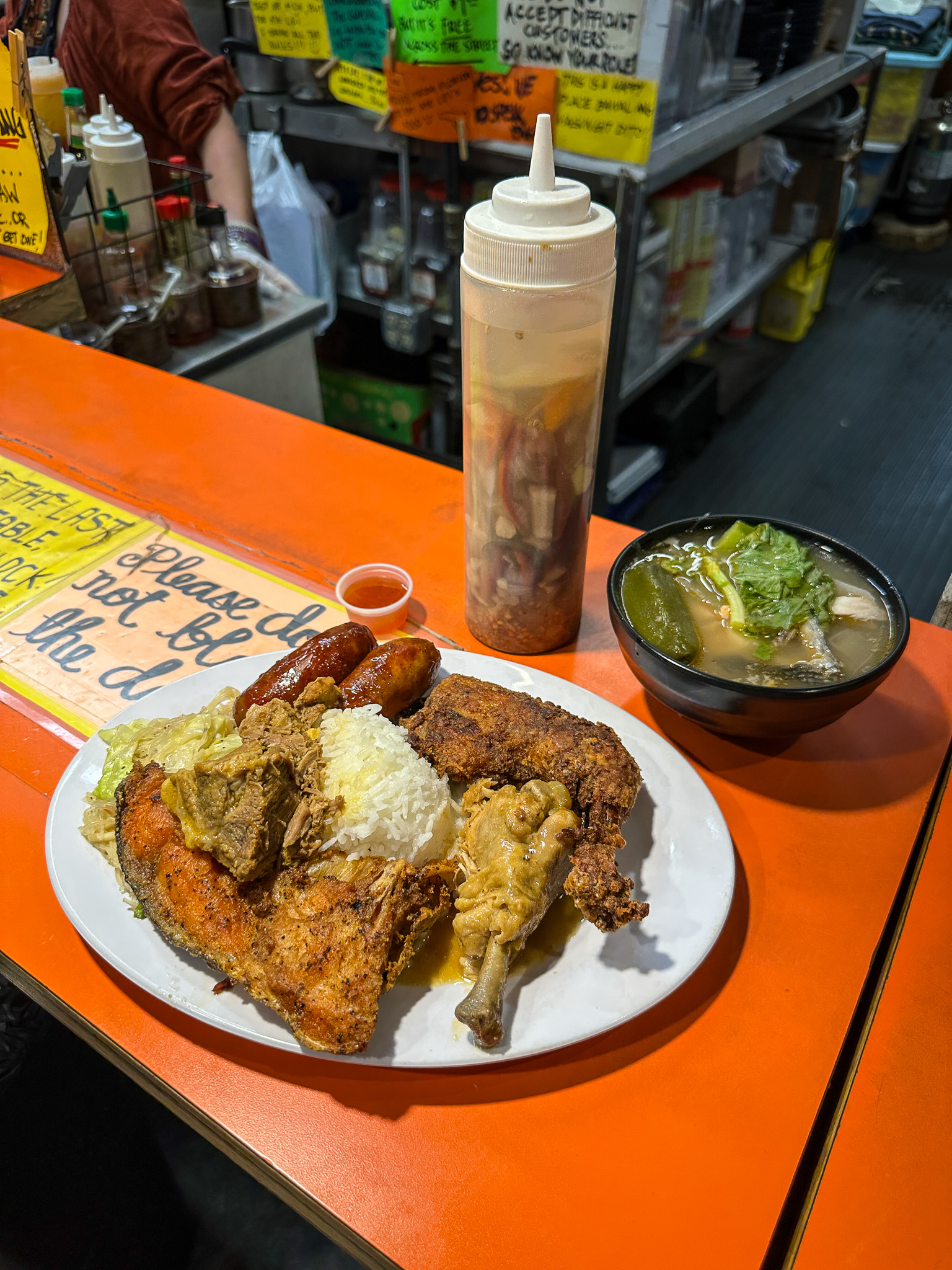
Mixed Plate from Oriental Market
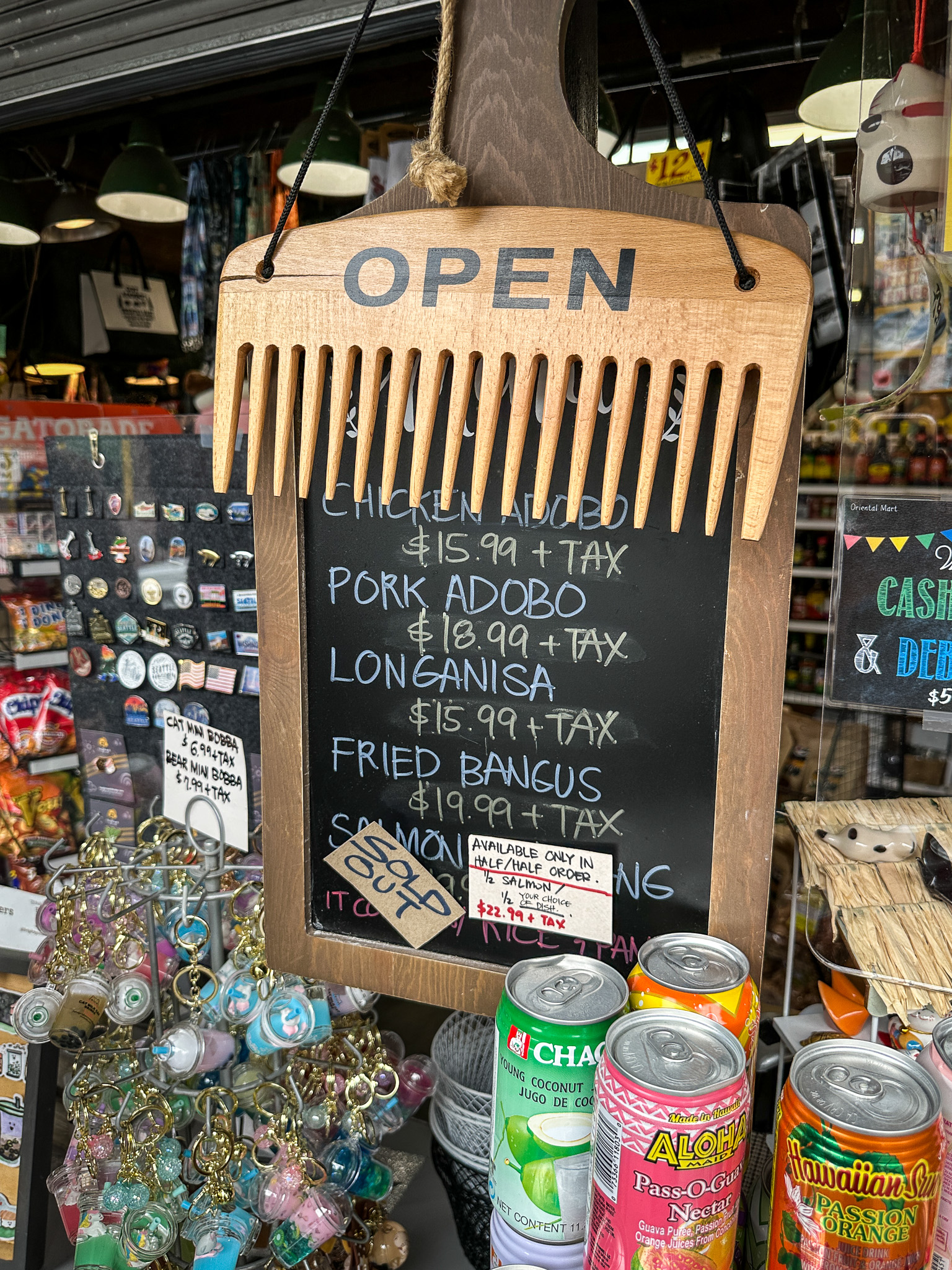
Oriental Mart Filipino Cuisine Menu
View this post on Instagram
Laing
Laing (pronounced Lah-ing) is a Filipino dish that consists of shredded or whole taro leaves with meat or seafood that is then cooked in a thick coconut milk spiced with labuyo chili, lemongrass, garlic, shallots, ginger, and shrimp paste. It originates from the Bicol Region, where it is known simply as pinangat.
Balut
Balut is a boiled duck egg with a semi-developed embryo aged between 16 to 21 days. The older it is, the more developed the embryo so you can expect to see the chick’s feathers, beak, and claws.
Eating balut is a textural thing, but once you get over it, you’ll find it very delicious. You start by cracking a hole on the rounded end, slurp the juice inside, sprinkle some salt, pepper and time in, and scoop it out and directly into your mouth. You’ll want to avoid the hard white part.
The juice tastes like gamey chicken soup and the yolk is creamy. We guarantee it tastes better than we’re making it sound.
Betute Tugak
Pampanga’s Betute is stuffed frog. This exotic dish makes use of frogs caught in farms, rivers, and rice paddies.
During preparation, the frog is cleaned thoroughly with its entrails, feet, and head removed. It is then stuffed with minced pork and finely chopped herbs and spices and then deep-fried in oil. It’s delicious, we promise. It actually tastes similar to chicken.
Entrees
Adobo
Abodo is another one of the more popular Filipino dishes. It’s essentially pork cooked in vinegar, soy sauce, garlic, bay leaf, and black peppercorns. Sometimes, eggs and potatoes are added but it’s best paired with a hot steaming bowl of rice.
If you ask any Filipino to name a national dish, they would most likely say adobo.
Every household has their own adobo recipe and may add ingredients such as coconut milk and turmeric to suit their regional palate. Aside from pork, some people prefer to make adobo with chicken. The meat is cooked until it’s very tender and bursting with flavor.
If you ask any foreigners what Filipino dish they remembered and liked the most, they usually mention pork or chicken adobo.
Kare Kare (Beef Peanut Stew)
Kare Kare (pronounced Kareh-Kareh) is a beef shank and oxtail with vegetables simmered in thick peanut sauce served with savory shrimp paste on the side. Eat it with a side of fragrant garlic rice.
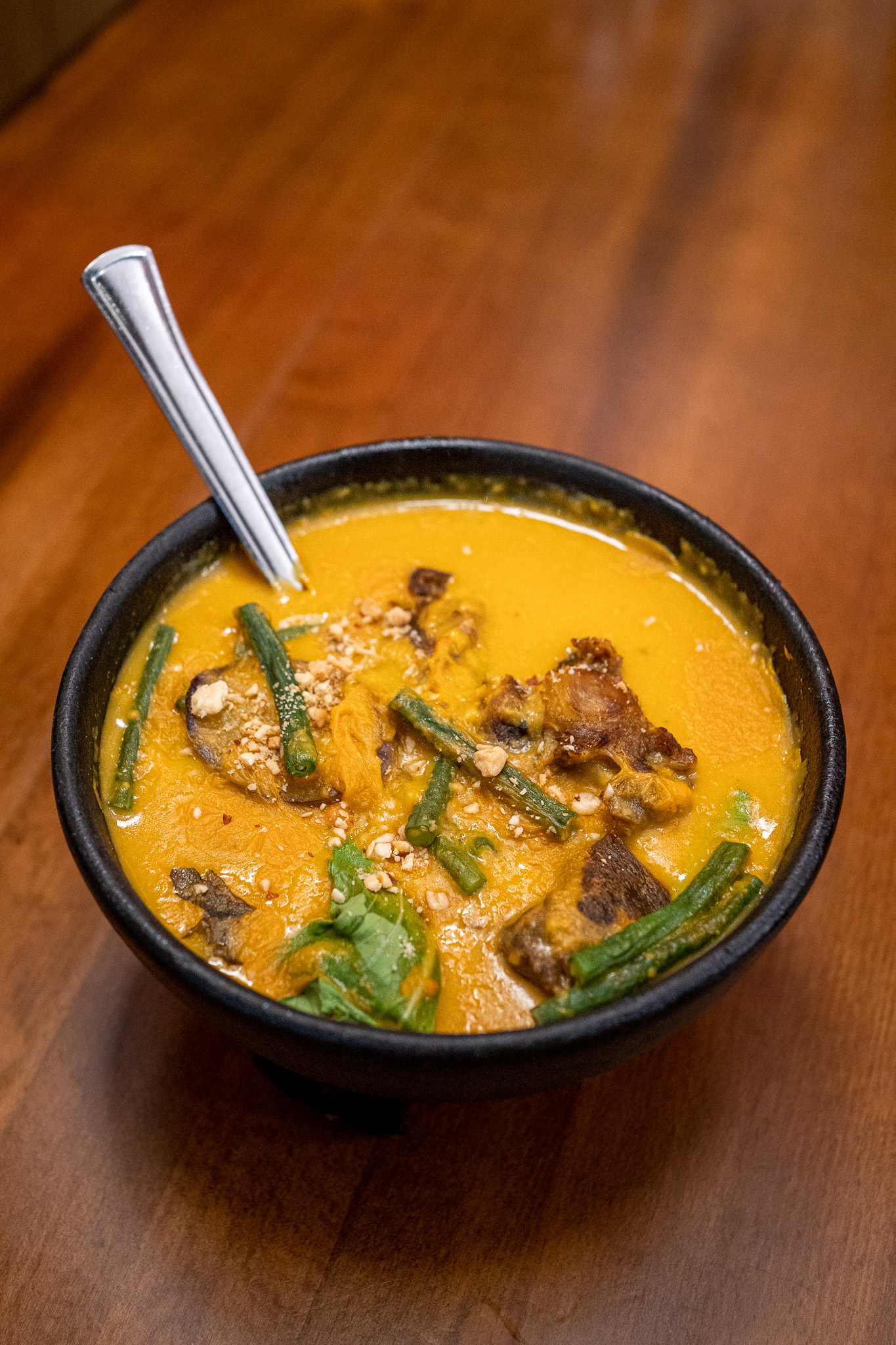
Kare Kare from Max’s Restaurant
Inasal
The Visayan islands offer the perfect dish. You will never taste anything like Inasal. It is fire-roasted chicken marinated in ginger, lemongrass, and calamansi juice. The chicken is then basted with annatto oil and served with rice, soy sauce dip, and sometimes liquid chicken fat, Inasal is definitely one of the Philippines food items you should not miss.
Crispy Pata (Crispy Pork Hock)
If you ever get a chance, you have to try Crispy Pata! It’s a pork hock simmered in a special marinade and then deep-fried to perfection. The dish is served with a soy vinegar dipping sauce but tastes great as is.
We make pork soup from the bones afterward so that nothing goes wasted.
In the Seattle area, you can try Crispy Pata at Max’s Restaurant in Tukwila, WA. We still dream about their Crispy Pata!
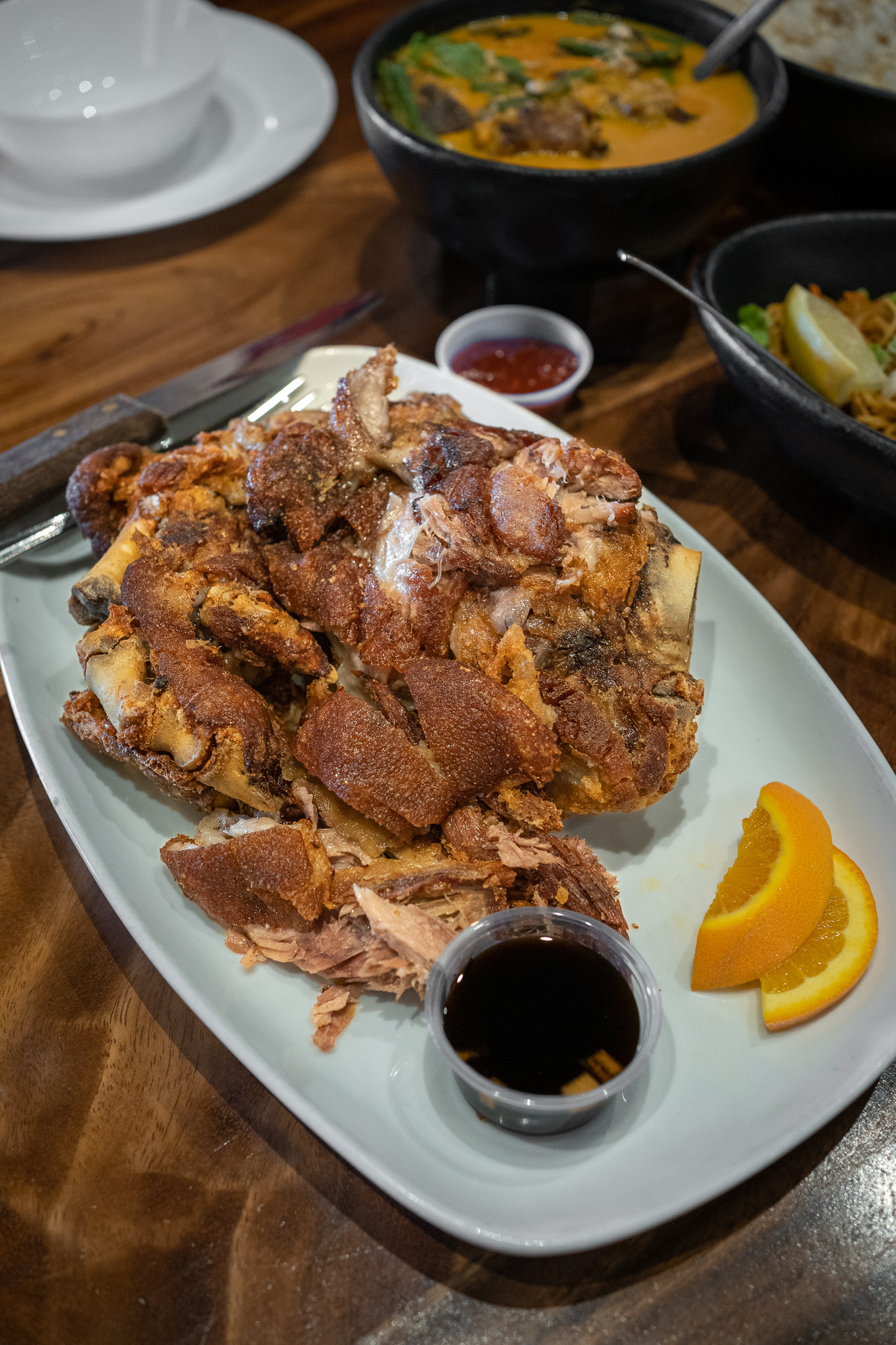
Crispy Pata from Max’s Restaurant
Daing Na Bangus (Boneless Milkfish)
This Whitefish is indigenous to the Philippines. It’s prepared in a flavorful vinegar garlic marinade, deep fried, and then served with our house relish and suka’t bawang (vinegar garlic dip) on the side. We love eating it as is or with rice.
Lechon Kawali
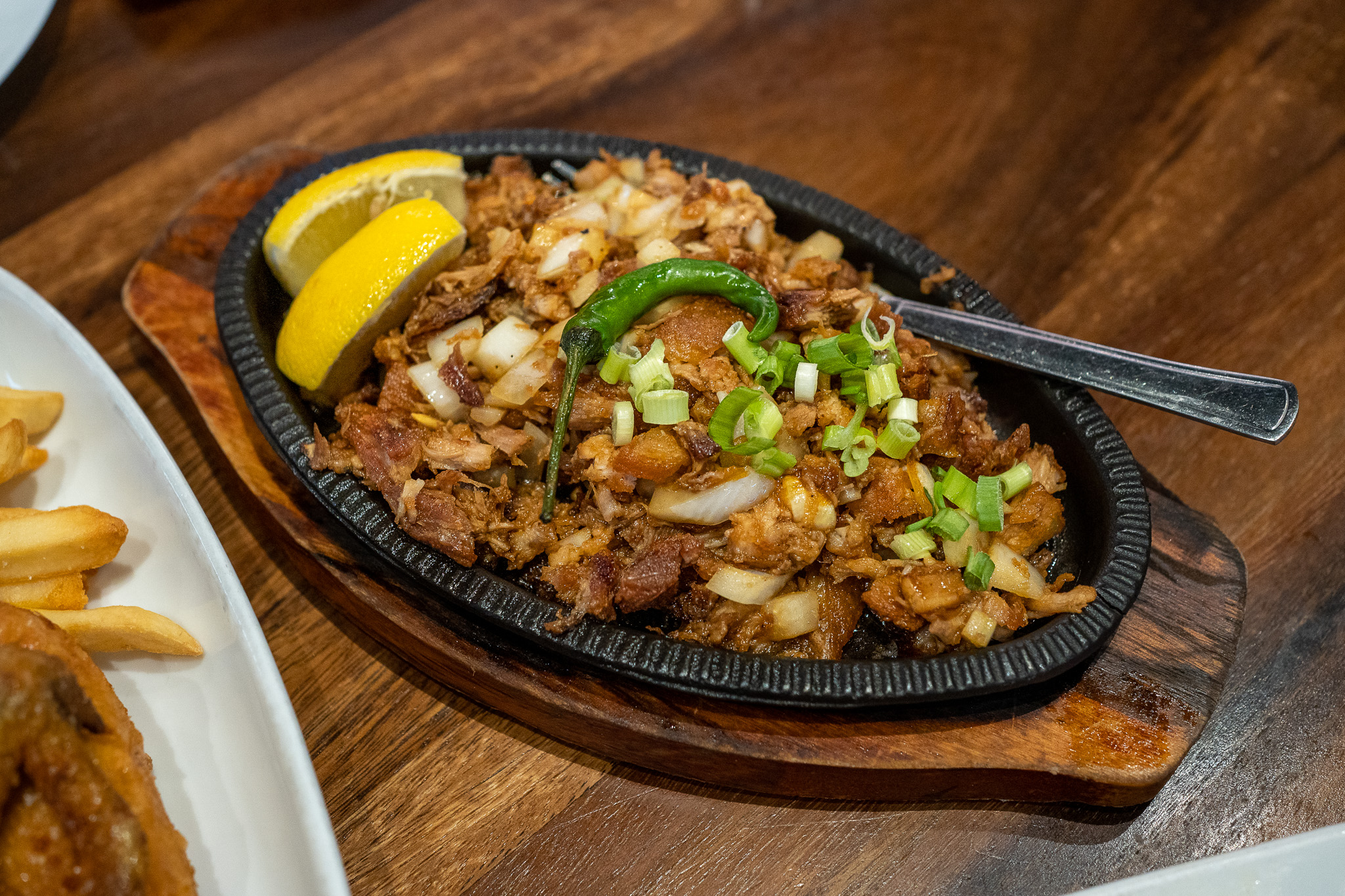
Lechon Kawali Sisig from Max’s Restaurant
Lechon Kawali is pork belly that is deep fried until it’s crispy and golden, yet soft and tender on the inside. It’s traditionally served cubed with liver sauce on the side but can be eaten alone or with rice.
Lechon Kawali can also be served sisig style which means diced and grilled on a hot skillet (see the above image).
One of our favorite preparations of Lechon Kawali is made by Kusina Ni Jayboy in Maui, Hawaii. They have a LOCO MOCO made with Lechon Kawali in place of the traditional burger patty. We always order this dish when we visit Maui and its honestly one of the things that keeps us coming back to the island.
Related: Maui Travel Guide | What to See, Eat and Do
View this post on Instagram
Bicol Express
If you like hot and spicy food, you’ll love Bicol Express. It’s a spicy pork stew cooked with coconut milk, shrimp paste, and loads of chili pepper. It’s believed to have originated from the Bicol region and was named after a train that used to travel between Manila and Bicol.
The meat is incredibly tender, and people often enjoy how creamy yet spicy the soup is. You can eat it alone or with rice.
Pancit
Essentially Filipino stir-fried noodles. The most common type of pancit is made with veggies, meat, and glass noodles.
Pancit can also be made with egg noodles (Canton style), rice noodles (bihon), thick noodles (balabok), and more. The possibilities are endless!
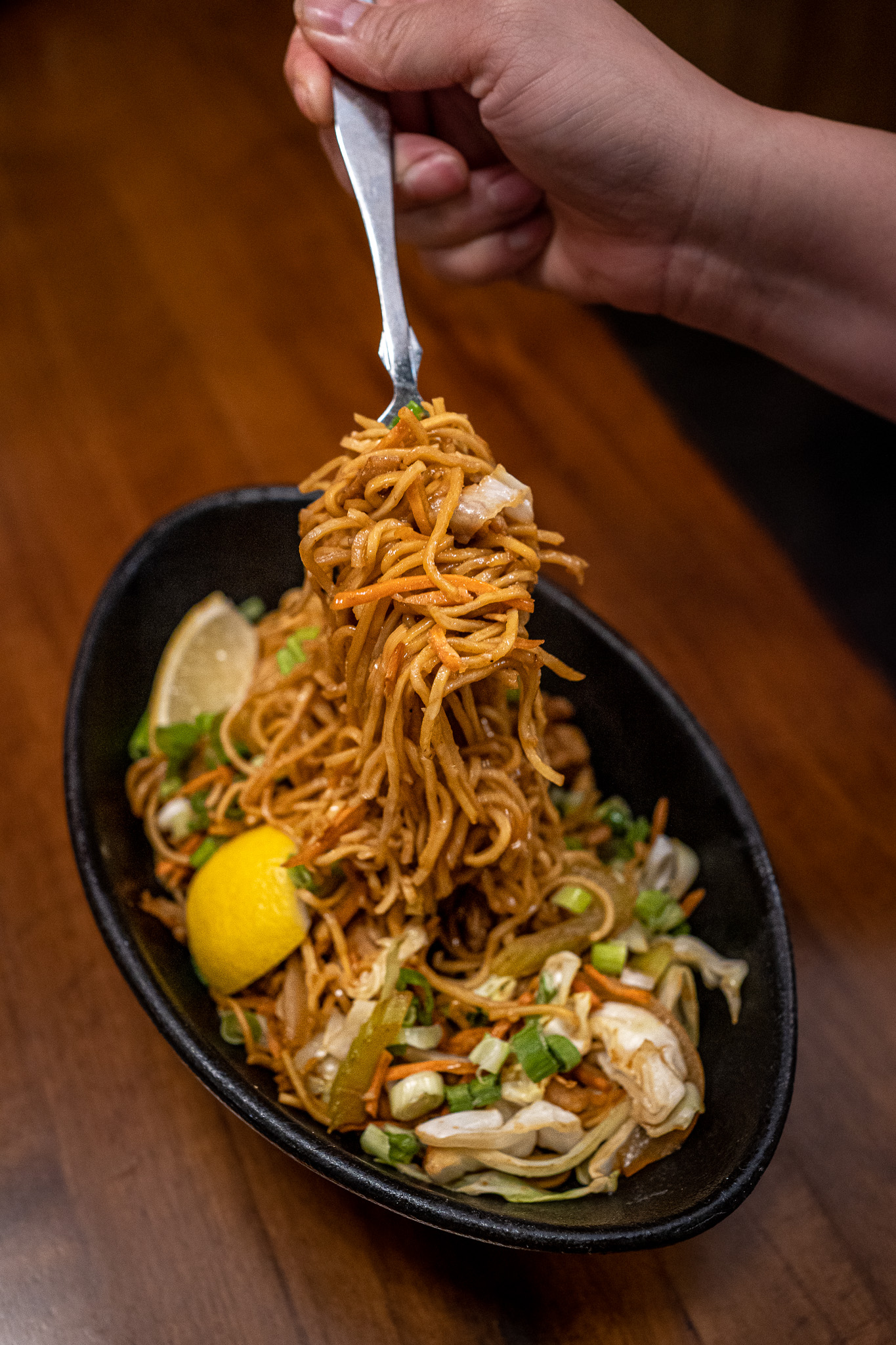
Pancit Canton from Max’s Restaurant
Soups
Bulalo
Bulalo is a tasty clear broth made with tender osso bucco and lots of vegetables. It’s a comfort food for many Filipinos.
Naligang
Tender beef shanks and ribs in a flavorful soup, with greens, potatoes, and peppercorns.
Sinigang
Sinigang is a tamarind soup that can be made with pork (baboy), beef (baka) and fish (typically milkfish or bangus), and veggies such as radish, taro, eggplant, string beans, tomato, and onion.
This tart and comforting soup can be eaten alone or with rice. We love how the rice soaks up the tangy broth with every bite. It’s one of the most popular Filipino dishes that is eaten at home while having dinner with family.
In Seattle, we got to try the famous salmon sinigang from Oriental Mart (@Omart1973). Their version of this soup is made with fresh fish caught and sold at the Pike Place Fish Market just across the way. Leila and Joy have been cooking and serving delicious home-cooked meals for over 50 years and were awarded the esteemed James Beard Award in 2020.
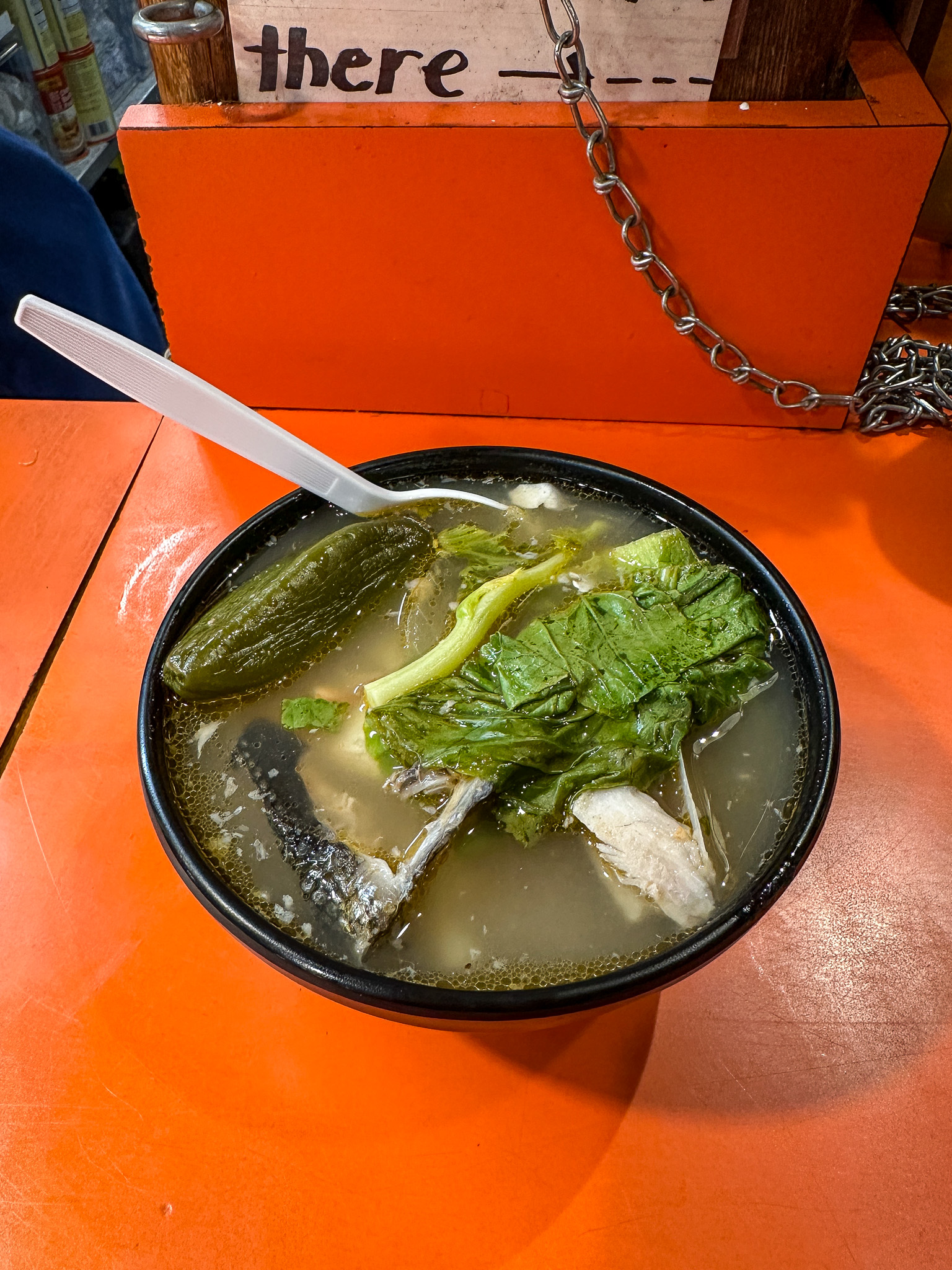
Watch our video dining at Max’s Restaurant where we got to try a lot of Filipino dishes including Sinigang.
View this post on Instagram
La Paz Batchoy
La Paz Batchoy is Iloilo’s signature delicacy. It’s essentially an egg noodle soup cooked with pork innards such as the liver, kidney, and heart and then garnished with ginger, spring onions, pork cracklings, and a raw egg.
It’s so popular that locals say no trip to Iloilo is complete without trying this comfort food. It’s sometimes paired with puto (Filipino steamed cake) or pandesal (a local bread roll).
We recommend going to La Paz market to get the most authentic bowl. On a rainy day, a piping hot bowl of La Paz Batchoy never fails to hit the spot. Take a tip from the local and finish the broth first. You can always ask for refills.
Tinolang Manok
Tinolang Manok is the ultimate comfort food for many Filipinos.
In fact, it has become synonymous with “home”, and a sip of this tasty broth automatically makes one nostalgic. It’s a chicken stew cooked with green papaya and chili leaves and flavored with onion, ginger, and fish sauce.
Some variants make use of the very nutritious malunggay (moringa leaves). Either way, the best tinolang manok is the one that makes use of native chicken.
It’s a very common meal in the Philippines especially in the provinces because the locals can simply catch one of their chickens in the backyard, harvest their own papaya and chilli leaves and that’s it!
Sides
Garlic Rice (Sinangag)
Sinangag is steamed white rice tossed with crispy golden garlic bits.
We’ve been cooking our rice this way since we discovered it at Ludi’s Diner in Downtown Seattle. Say goodbye to boring rice!
Pinakbet
Pinakbet is a mix of fresh vegetables sautéed with pork, shrimp, and shrimp paste. It has a super savory flavor and pairs well with rice.
It’s a popular dish that comes from the Northern Ilocos region.
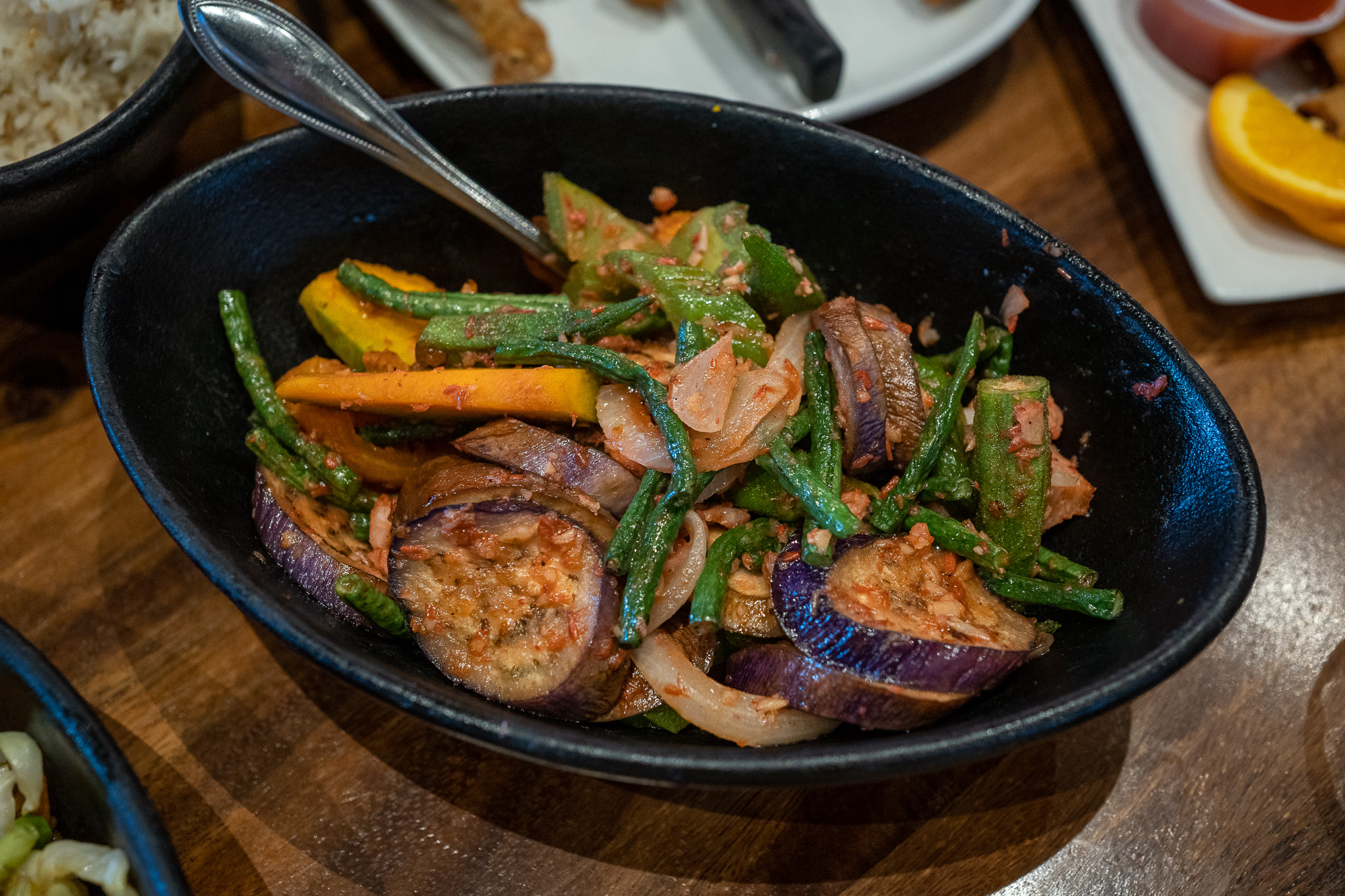
Pinakbet from Max’s Restaurant
Banana Ketchup
Banana Ketchup is the condiment of choice for Filipino cuisine. It tastes great as an ingredient and as a dipping sauce for fried foods and more.
Suka’t Bawang (vinegar garlic dip)
This dip goes with all sorts of proteins, especially deep fried ones.
Dessert
Halo Halo
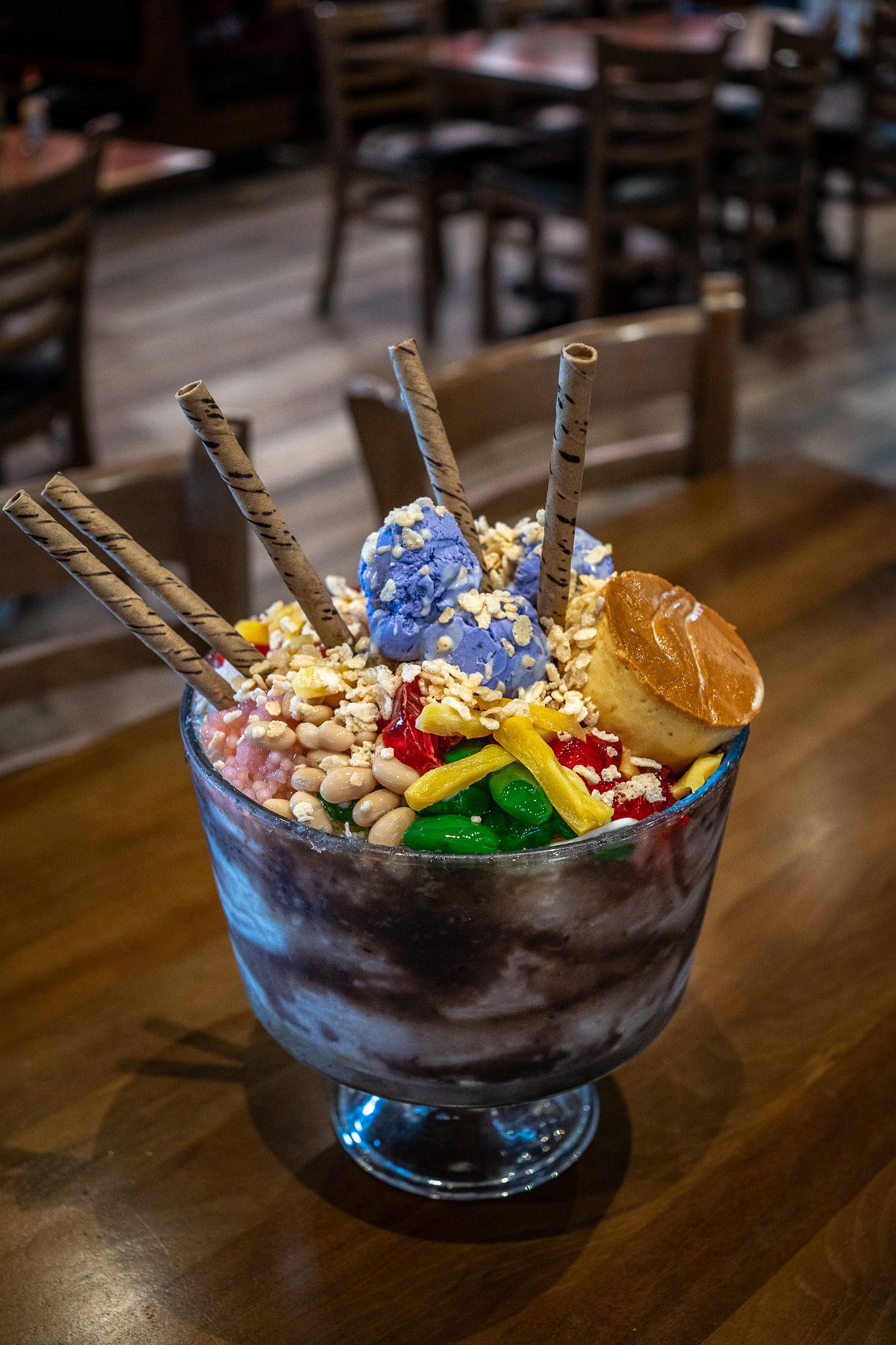
Giant Halo Halo from Max’s Restaurant
Halo-Halo translates to “Mix Mix.” It’s a Filipino shaved ice dessert that is topped with fruit, beans, jellies, evaporated milk, ube ice cream, ube paste, creamy flan, and crunchy toasted pinipig (pounded flat rice).
It’s a colorful combination that mixes into a creamy and refreshing treat. You’ll experience creamy, soft, and chewy textures that are as fun to eat as it is to look at.
Max’s Restaurant sells a GIANT Halo Halo that is big enough for 10 people! It was bigger than the size of my head! I got to try it and share it with friends. They have multiple locations throughout the United States, Hawaii, and the Philippines. Be sure to check them out for some delicious home-cooked Filipino food.
View this post on Instagram
Sago’t Gulaman (Tapioca and Gelatin)
A tapioca and gelatin dessert that is flavored with brown sugar syrup and a hint of banana extract. It’s served over shaved ice and served in a tall glass.
Buko Pandan
This refreshing dessert includes young coconut mixed with Pandan Leaf (screwpine) gelatin and tapioca in a rich fluffy cream sauce, with Macapuno (coconut) ice cream and rice flakes.
Drinks
Calamansi (Filipino Lime)
A refreshing juice fresh squeezed from Filipino limes known as Calamansi. Calamansi are lime is green on the outside and orange inside and has a tangy yet sweet and refreshing flavor.
Coconut Juice with Coconut Meat
This refreshing drink is made from the juice of a fresh coconut and the tender meat scraped out of the shell.
What were some of your favorites from our popular Filipino dishes roundup? Tell us in the comments!
If you found our article on popular Filipino dishes you have to try helpful, please share it. Thanks for your support!
Thank you for visiting today! If you found this encouraging or informative, please connect with us on Instagram or TikTok. Sign up for our monthly newsletter for updates and more. We promise we won't spam you! Feel free to unsubscribe anytime. If you're a brand and want to work with us, please visit this page to get in touch.

